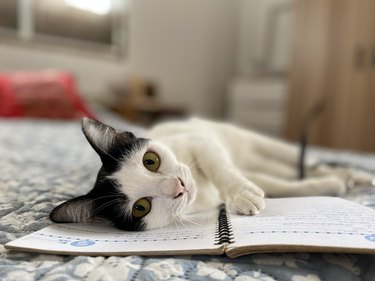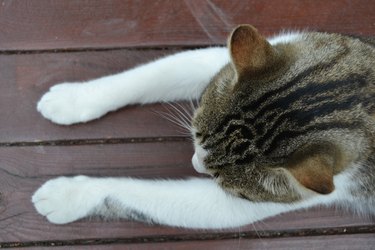Despite their tendency to indulge in a relaxing nap (or five) every day, our feline friends are on their feet an enormous amount, especially if they're allowed to wander the terrain as outdoor cats. Like people, the bottoms of a cat's feet can become hardened, worn, or cracked over time.

Video of the Day
Damaged cat paw pads can be attributed to a number of causes, from environmental factors to injuries to their overall physical health including age. However, treating your cat's dry paw pads is usually easily done, especially when you can identify the underlying cause of footpad dryness.
Video of the Day
The function of cat paw pads
We know that cats use their feet for standing, walking, running, and pouncing, and it takes a set of healthy paws in order to allow any and all of those skills to happen, even for indoor cats. The pads on the bottoms of your cat's feet work to absorb traction and shock encountered during movement on the ground.
Each paw pad is comprised of keratinized skin, but around and under the paw pads are bones, ligaments, blood vessels, nerves, and tendons. Feline paw pads offer protection to the ligaments, tendons, and bones inside of the legs anytime your cat jumps, runs, climbs, or even walks. Kitten paw pads, sometimes called cat toe beans, start out very soft and delicate, but get rougher over time through normal wear and tear.
Cat paw moisturizer
Sometimes, people need a little extra help to keep their skin soft, supple, and healthy, and our cat's skin is no different. In the same way that balm or lotion works to hydrate and lock in moisture on our own skin, topical creams can help soften and moisturize dry pads on your cat's feet.
If you don't have a product specifically for paw pads, try gently rubbing Vaseline into your cat's paw pads two to three times a week. You can also try applying a small amount of olive oil or coconut onto your cat's paw pads as an all-natural alternative to petroleum jelly.
Avoid using moisturizers designed for humans. When reaching for creams and treatments, it's also important to stay away from anything that might lead to irritation or toxicity to your cat, including cortisone cream and tea tree oil. For severe dryness, consult your veterinarian about a possible dietary deficiency and other possible causes.

Dry skin issues and cat health
It's important to note that heavily cracked, swollen, and bleeding paws are not normal for cats, and could be symptomatic of low protein or fatty acid levels in your cat — paw pads this damaged can also be symptoms of feline leukemia virus or feline immunodeficiency often referred to as FIV.
If your cat is old or aging, cracked or severely dry paw pads can indicate a possible liver or kidney dysfunction, which prevents the proper absorption of certain nutrients found in your cat's food. Finally, always make sure your cat and his body are properly hydrated by making fresh, clean water available at all times. This can also pose a problem when they use the litter box, because they may be reluctant to hurt their paws when they scratch at the cat litter.
Cat paw care and injuries
If you notice that your feline has an injury on her foot or paw pads or that one of your cat's nails has torn off, it is recommended that you address the problem immediately to prevent possible further injury to your cat. An injury might present itself as a small scratch or sore, or it might look as serious as a cat paw pad peeling off. Either way, clean the wound with water, a damp cloth, and antibacterial soap right away, keeping an eye out for foreign objects lodged into your cat's paw, such as a thorn or wood splinter.
If your cat's paw is bleeding, apply pressure to the wound using a clean towel and take your cat to the veterinarian if the bleeding continues for more than 15 minutes. If you can get the bleeding to stop, wrap your cat's foot in gauze, taking care to cover the toes and wrapping all the way up over the ankle to ensure that it stays in place.
Change the bandage every day and schedule an appointment for your cat to be seen by a veterinarian. Depending on the location and extent of the paw wound, your cat might need stitches to help the wound heal. They might also need antibiotics because, despite the necessity of a bandage in some cases, bandages can trap moisture, which makes an infection more likely to occur and impact your cat's wellness.
The bottom line
Cat paw pads can become rough, cracked, or dry over time. Some wear on feline paws is normal, but mild dryness or cracking can be relieved by applying olive oil, coconut oil, or feline paw pad balms to a cat's feet. Note, however, that excessive paw pad damage such as swelling or bleeding can be symptoms of significant health and immune system issues, skin conditions, dietary problems, or injury — these symptoms require immediate veterinary attention as part of good cat care.